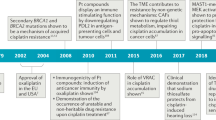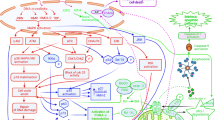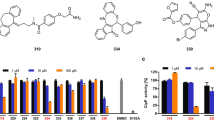Abstract
Puromycin-resistant (PurR) mutants/variants of a human carcinoma cell line (HeLa), which show greatly reduced cellular uptake of 3H-puromycin and 3H-daunomycin have been isolated after one- and two-step selections in presence of the drug. The cross-resistance pattern of these mutant cell lines towards numerous anticancer drugs and other inhibitors has been examined. Both the first- and the second-step mutants exhibited increased resistance to a number of antimitotic drugs (viz. vinblastine, vincristine, colchicine, taxol and maytansine), several protein synthesis inhibitors (viz. chalcomycin, bruceantin, harringtonine, homoharringtonine), a large number of DNA interactive compounds (viz. aclacinomycin A, actinomycin D, adriamycin, m-AMSA, chromomycin A3, coralyne sulphoacetate, daunomycin, ellipticine, mithramycin, mitoxantrone, 5-methoxysterigmatocystin, rubidazone, variamycin, VM26 and VP16-213) and a number of other drugs acting via other mechanisms (viz. Baker's antifol, nitidine chloride and rhodamine 123). Whereas the first-step mutants showed stable resistance to these drugs, the second-step lines partially reverted upon growth in non-selective medium. Further, treatment of these mutant lines with non-cytotoxic doses of the calcium channel blocker verapamil reverted or abolished their resistance to the above drugs in a dose-dependent manner. In contrast to the above compounds, the PurR mutants showed no significant cross-resistance to a large number of other drugs which included asaley, AT-125, 5-azacytidine, azaserine, cyclocytidine, cis-platin, cytosine arabinoside, chlorambucil, chlorpromazine, alpha-difluoromethyl ornithine, 5-fluorouracil, ftorafur, gallium nitrate, hydroxyurea, ICRF-159, ICRF-187, imipramine, methotraxate, 6-methylmercaptopurine riboside, mycophenolic acid, melphalan, mitomycin C, methyl GAG, nafoxidine, reumycin, 6-selenoguanosine, 6-thioguanine, tiazofurin, tamoxifen, thalicarpine, tiapamil and verapamil). These cross-resistance data should prove useful in developing suitable drug combinations to which cellular resistance would not develop readily.
This is a preview of subscription content, access via your institution
Access options
Subscribe to this journal
Receive 24 print issues and online access
$259.00 per year
only $10.79 per issue
Buy this article
- Purchase on Springer Link
- Instant access to full article PDF
Prices may be subject to local taxes which are calculated during checkout
Similar content being viewed by others
Author information
Authors and Affiliations
Rights and permissions
About this article
Cite this article
Gupta, R., Murray, W. & Gupta, R. Cross resistance pattern towards anticancer drugs of a human carcinoma multidrug-resistant cell line. Br J Cancer 58, 441–447 (1988). https://doi.org/10.1038/bjc.1988.237
Issue Date:
DOI: https://doi.org/10.1038/bjc.1988.237
This article is cited by
-
Promising bioactive compounds from the marine environment and their potential effects on various diseases
Journal of Genetic Engineering and Biotechnology (2022)
-
Molecular analysis of the multidrug transporter
Cytotechnology (1993)
-
Patterns of cross-resistance in a multidrug-resistant small-cell lung carcinoma cell line
Cancer Chemotherapy and Pharmacology (1990)



